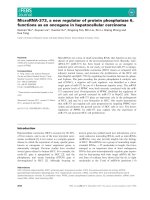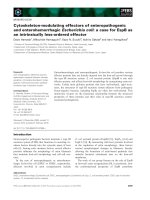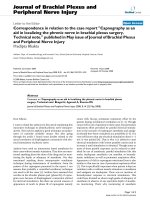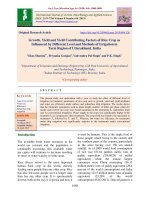Profile and opinion of women farmer towards farming as an occupation in tribal setting of Uttarakhand, India
Bạn đang xem bản rút gọn của tài liệu. Xem và tải ngay bản đầy đủ của tài liệu tại đây (231.96 KB, 9 trang )
Int.J.Curr.Microbiol.App.Sci (2019) 8(1): 1384-1392
International Journal of Current Microbiology and Applied Sciences
ISSN: 2319-7706 Volume 8 Number 01 (2019)
Journal homepage:
Original Research Article
/>
Profile and Opinion of Women Farmer towards Farming as
an Occupation in Tribal Setting of Uttarakhand, India
Ritu Shah*, A.K. Singh and Manohar Saryam
Dept. of Extension Education, Institute of Agricultural Sciences, Banaras Hindu University,
Varanasi, UP, India
*Corresponding author
ABSTRACT
Keywords
Farm women,
Farming,
Occupation,
Opinion, Tribal
Article Info
Accepted:
10 December 2018
Available Online:
10 January 2019
The present study attempts to view the profile of tribal women farmers of Uttarakhand and
their opinion towards farming as an occupation. The study was purposively conducted in
Uttarakhand. From the state two districts and from each district two blocks were randomly
selected. From each block two villages were selected randomly. And from each village 25
respondents were randomly selected. To rank the opinion at aggregate level, Garrettt’s
Ranking Technique was used. The results showed that majority (46 %) of overall
respondents belongs to young age category and majority (34.50 %) of the overall
respondents had primary level education. Majority (73.5 %) of overall respondents had
agriculture as their primary occupation. Majority of the respondents (58.50 %) were from
nuclear family and majority of overall respondents (62 %) were marginal farmer having
land holding less than 2.48 acre. Family occupation was ranked first by the respondents for
reason of taking farming as an occupation. Majority of the respondents found that timely
availability of quality seeds and other inputs was the most important step needed to
enhance attractiveness of farming occupation.
Introduction
Farming
as
a
profession
provides
opportunities to contribute in the mission of
eradicating hunger and enabling food security.
Farming has been successfully used as a tool
of women empowerment in the rural settings
where women are financially dependent upon
men totally. According to Census 2011, India
has a population of 1.21 billion. More than
800 million Indians live in rural areas and 400
million live in urban areas. Scheduled Tribes
(STs) constitute 8.6 per cent of the country’s
population. In developing countries migration
of men in search of paid employment and
rising mortalities attributed to increase
numbers of female-headed households which
is more visible in hilly region of Uttarakhand.
Both women and men play critical roles in
agriculture throughout the world. Rural
women in particular are responsible for half of
the world’s food production and produce
between 60 and 80 per cent of the food in
most developing countries. Despite their
contribution to global food security, women
farmers are frequently underestimated and
sidelined in development strategies (FAO,
2011). Farm Women is an integral part of the
1384
Int.J.Curr.Microbiol.App.Sci (2019) 8(1): 1384-1392
human society. Women contribute one third
labour force required for farming operations
and allied enterprises. They have been playing
significant role in Home, farm and Allied
activities. In Indian context farming is a
family occupation. They play a variety of roles
with greater responsibilities in upbringing of a
healthy society. They play active role in
supporting their households and communities
in achieving food and nutrition security,
generating income, and improving rural
livelihoods and overall well-being. They also
contribute to agriculture and rural enterprises
and local and global economies. Active
participation of women in the entire
development process is essential for the
overall socio-economic development of any
country. Therefore, raising the status of
women in general and that of socially and
economically backward women in particular is
not just a moral imperative but also a strategic
one. In Uttarakhand the work force engaged in
agricultural activities is 58.39 % of total work
force. The share of female work force in total
work force is 36.31 %. The occupational
distribution (2001 census) indicates that the
share of cultivators is predominant in
occupational structure. In India work
participation of tribal women is the highest
and even better than the participation of men.
Work participation rate of tribal women is
43.5, whereas national average (for general
population) is 25.5. Though the overall work
participation rate decreased from 25.6 to 25.5,
it is increased in urban areas. So given the
feminization era of agriculture and even more
prominent role of women, especially in tribal
communities where women is providing
livelihood support to family by increasingly
getting involved in farming related activities
often by choice and often as a sole option, it is
crucial to undertake an intensive study to look
into their perspective. Given the diversity of
tribal communities living in Himalayan hill
and most intensive participation of women in
agriculture and allied sector in hilly region a
study on tribal women farmer has been
conducted.
Materials and Methods
The study was conducted in Chamoli and
Dehradun districts of Uttarakhand. The data
was collected from a sample of 200 tribal farm
women 100 from each tribe i.e. Bhotiya
(Chamoli) and Jaunsari (Dehradun). In the
present study opinion has been operationalized
as opinion towards reason for choosing
farming as an occupation, Steps needed to
enhance attractiveness in this occupation,
Farming as a tool of women empowerment,
Reasons behind desire to undertake other
occupation, Difficulties faced in practicing
farming as a women and social acceptance of
being a women farmer in respective
community other occupation from farm and
non-farm. A set of open ended questions were
prepared in order to find the opinion of
respondents. Information regarding the
opinion by the farm women was procured and
respondents were asked to rank them. To rank
the opinion at aggregate level, Garrettt’s
Ranking Technique was used. The prime
advantage of this technique over simple
frequency distribution is that the opinions are
arranged based on their priority from the point
of view of respondents. Hence, the same
number of respondents on two or more
opinion may have been given different rank.
Garrettt’s formula for converting ranks into
per cent is:
Per cent position = 100 * (Rij – 0.5)/Nj
Where,
Rij = rank given for ith constraint by jth
individual;
Nj = number of constraint ranked by jth
individual.
The per cent position of each rank was
converted into scores referring to the table
1385
Int.J.Curr.Microbiol.App.Sci (2019) 8(1): 1384-1392
given by Garrettt and Woodworth (1969). For
each factor, the scores of individual
respondents were added together and divided
by the total number of the respondents for
whom scores were added. These mean scores
for all the constraints were arranged in
descending order; the opinions were
accordingly ranked.
Results and Discussion
A perusal of the Table 1 indicate that majority
(46 %) of overall respondents belongs to
young age category followed by middle aged
(31 %) and old aged (23 %). Majority (51 %)
of respondents from Bhotiya tribe and 41 per
cent from Jaunsari tribe belongs to young age
followed by middle and old aged.
Data regarding education shows that majority
(34.50 %) of the overall respondents had
primary level education followed by middle
level (22 %), illiterate (15.50 %), intermediate
level (14.50 %) and high school level (13.50
%) education respectively. In both the tribe
maximum number of respondents had primary
level education i.e. in Bhotiya (28 %) and in
Jaunsari (41 %). In Bhotiya tribe primary level
education was followed by Intermediate (26
%), High school (17 %), Middle level (15 %)
and Illiterate (14 %). In Jaunsari tribe primary
level of education was followed by middle
level (29%), illiterate (17 %), high school (10
%) and intermediate (03 %).
A cursory look at the Table 1 also reveals that
majority (73.5 %) of overall respondents had
agriculture as their primary occupation
followed by handicraft (26.50 %). In Bhotiya
tribe majority of respondents had handicraft as
their primary occupation followed by
agriculture (47 %) whereas in Jaunsari tribe all
the respondents had one occupation i.e.
agriculture. Table also shows that majority
(26.5 %) of respondents had agriculture as
their secondary occupation and that too
belongs to only Bhotiya tribe (53 %) followed
by handicraft (47 %). Data regarding family
type of respondents presented in the table
shows that majority of the respondents (58.50
%) were from nuclear family and 41.50 per
cent respondent belonged to joint family. In
both the tribe i.e. Bhotiya and Jaunsari,
majority of respondents (66 % and 51 %) were
having nuclear family type followed by
respondent who had joint family (34 % and 49
%) respectively.
The perusal of table reveals that majority of
overall respondents (61 %) had small size of
family followed by the respondents who had
medium size of family (34 %) and respondents
who had large family size (05 %). In Bhotiya
tribe majority of respondents (72 %) had small
size of family followed by medium size of
family (28 %) while in Jaunsari tribe half of
the respondents (50 %) had small size of
family followed by medium size of family (40
%) and large size of family (10 %).
A cursory look on the Table 1 shows that
majority of overall respondents (62 %) were
marginal farmer having land holding less than
2.48 acre followed by small farmers (21 %)
who were having landholding between 2.48 to
4.67 acre and large farmer (17 %). In Bhotiya
tribe all the respondents were marginal
farmers (100 %) while in Jaunsari tribe
maximum respondents (42 %) were small
farmers followed by large farmers (34 %) and
marginal farmers (24 %). In Bhotiya tribe no
farmer was found in the category of small and
large farmer. The farmers in the area had been
mostly marginal farmers. The average size of
land holding had been found to be 21.00 Nali
(1acres = 20 Nali). This land was not
concentrated at one place but in the form of
small undulated plots dispersed in different
areas.
Data regarding possession of livestock by
respondent’s shows that majority of the
respondents (68 %) had small size of livestock
1386
Int.J.Curr.Microbiol.App.Sci (2019) 8(1): 1384-1392
followed by 19.50 per cent respondents who
were having medium size of livestock. Rest
12.50 per cent respondents possessed large
size of livestock. In Bhotiya tribe all the
respondents have small size of livestock while
in Jaunsari tribe maximum respondents (39 %)
were having medium size of livestock
followed by the respondents (36 %) who were
having small size of livestock and the
respondents (25 %) who were having high size
of livestock.
In Bhotiya tribe they have a culture of
migration. They live for six months in two
valleys of Uttarakhand i.e. Niti and Mana
from April to October and then from October
to March some other areas where they also
have their permanent house in Chamoli
district. So, that is the reason they were having
less size of livestock. Jaunsari tribe is totally
into agriculture and majority of respondents
having medium size of livestock.
Data regarding farming experience in shows
that maximum number of overall respondents
(48 %) had low farming experience followed
by the respondents (33.50 %) who had
medium farming experience and respondents
(18.50 %) who had high farming experience.
In both the tribes majority of respondents
(Bhotiya: 54 % and Jaunsari: 42 %) had low
farming experience followed by respondents
who had medium farming experience and
respondents who were having high farming
experience.
Extension agency contact is referred to as the
frequency of meeting of the beneficiary with
extension personnel of various development
Data regarding contact of respondents with
extension agency has been presented in Table
1. Table shows that majority (57.50 %) of the
respondents were having contact with the
extension agency remaining 42.50 per cent
were not having any contact with the
extension agency. departments.
A perusal of Table 1 reveals that most of the
respondents (37.50 %) had Rice-Wheat and
Fingermillet/Horse gram (Gahat)-Pea-Potato
cropping pattern followed by the respondents
(25 %) who were having Rice-Potato-Wheat
cropping pattern. 20 per cent respondents had
Rajma/Horse gram (Gahat)-Wheat cropping
pattern and rest 17.50 per cent respondents
had Paddy/Maize-Potato/Oilseed (Mustard)Wheat cropping pattern. In Bhotiya tribe most
of
the
respondents
(40
%)
had
Fingermillet/Horse gram (Gahat)-Pea-Potato
cropping pattern followed by respondents (35
%) who had Rice-Wheat cropping pattern and
respondents (20 %) who followed RicePotato-Wheat cropping pattern. 15 per cent
were having Rajma/Horse gram(Gahat)-Wheat
cropping pattern and rest 10 per cent
were having Paddy/Maize-Potato/Oilseed
(Mustard)-Wheat cropping pattern. In Jaunsari
tribe most of the respondents (40 %) had RiceWheat cropping pattern followed by
respondents (35 %) who had Fingermillet/
Horse gram (Gahat)-Pea-Potato cropping
pattern and respondents (30 %) who followed
Rice-Potato-Wheat cropping pattern. 25 per
cent
were
having
Rajma/Horse
gram (Gahat)-Wheat and Paddy/MaizePotato/Oilseed(Mustard)-Wheat
cropping
pattern.
Data regarding migration pattern depicts that
majority of overall respondents (72.50 %) who
do not migrate and in which 45 per cent were
from Bhotiya tribe while all the respondents
(100 %) from Jaunsari tribe. Rest 27.5 per cent
respondents migrate and all belong to Bhotiya
tribe only. In Bhotiya tribe they have a culture
of migration. They live for six months in
villages of two valleys of Uttarakhand i.e. Niti
and Mana from April to October where they
perform farming and sell handicraft products
and then from October to March some other
areas in Chamoli district where they prepare
handicraft products mainly.
1387
Int.J.Curr.Microbiol.App.Sci (2019) 8(1): 1384-1392
Table.1 Profile of women farmer in tribal setting of Uttarakhand
S.N
Variable.
1.
Age
(Years)
2.
3.
4
5.
6.
9.
10.
Category
Young (<40.52)
Middle (40.52.54.69)
Old (>54.69)
Total
Education
Illiterate
Primary
Middle
High School
Intermediate
Total
Occupation Primary Occupation
Agriculture
Handicraft
Total
Secondary
Occupation
Handicraft
Agriculture
Not any other
Total
Type of
Nuclear
family
Joint
Total
Size of
Small (<9)
family
Medium (9-13)
Large (>13)
Total
Land
Marginal farmer
holding
(<2.48)
(Acres)
Small farmer (2.484.67)
Large farmer (>4.67)
Total
Size of
Small (<25)
livestock
Medium (25-43)
Large (>43)
Total
Farming
Low (<22.42)
Bhotiya
(n1=100)
Percentage
51
31
Jaunsari
(n2=100)
Percentage
41
31
18
100
14
28
15
17
26
100
Overall (n=n1+n2)
Frequency Percentage
92
62
46
31
28
100
17
41
29
10
03
100
46
200
31
69
44
27
29
200
23
100
15.5
34.5
22
13.5
14.5
100
47
53
100
100
00
100
147
53
200
73.5
26.5
100
53
47
00
100
66
34
100
72
28
00
100
100
00
00
100
100
51
49
100
50
40
10
100
24
53
47
100
200
117
83
200
138
52
10
200
124
23.5
26.5
50
100
58.5
41.5
100
69
26
05
100
62
00
42
42
21
00
100
100
00
00
100
54
34
100
36
39
25
100
42
34
200
136
39
25
200
96
17
100
68
19.5
12.5
100
48
1388
Int.J.Curr.Microbiol.App.Sci (2019) 8(1): 1384-1392
experience
11.
13.
14.
Extension
agency
contact
Cropping
pattern
Migration
pattern
Medium (22.4232.55)
High (>32.55)
Total
Yes
No
Total
Rice-Wheat
Rice-Potato-Wheat
Rajma/Horse
gram(Gahat)-Wheat
Paddy/MaizePotato/Oilseed(Musta
rd)-Wheat
Fingermillet/Horse
gram(Gahat)-PeaPotato
Within district
Do not migrate
Total
34
33
67
33.5
12
100
18
82
100
35
20
15
25
100
67
33
100
40
30
25
37
200
85
115
200
75
50
40
18.5
100
42.5
57.5
100
37.5
25
20
10
25
35
17.5
40
35
75
37.5
55
45
100
00
100
100
55
145
200
27.5
72.5
100
Table.2 Reasons behind taking up farming as occupation (n=200)
S.N
1
2
3
4
5
Factors
Family occupation
There is no other occupation
Required low initial investment
Required no educational qualification
It is a profitable venture
Garrett Score
68.075
61.46
47.195
45.21
27.12
Rank
I
II
III
IV
V
Table.3 Steps needed to enhance attractiveness of this occupation (n=200)
S.N
1
2
3
4
5
Factors
Timely availability of quality seeds and other
inputs
Improving access to credit, technology and
markets
Improving access to modern technology
Reduce drudgery by using women friendly tool
Promote organic farming/ high value crop etc
1389
Garrett Score
65.15
Rank
I
64.80
II
52.72
36.38
30.15
III
IV
V
Int.J.Curr.Microbiol.App.Sci (2019) 8(1): 1384-1392
Table.4 Farming as a tool of women empowerment (n=200)
S.N
1
2
3
Factors
A source of income for the family
An identity of being a woman farmer
Recognition of traditional/indigenous knowledge of
women by documentation, validation and dissemination
The stereo-typed attitude of male extension agents should
be changed with regular gender sensitization courses
4
Garrett Score
68.60
56.34
44.32
Rank
I
II
III
31.93
IV
Table.5 Reasons behind desire to undertake other occupation (n=200)
S.N
1
2
3
4
5
Factors
Farming do not provide a regular source of
income
Not getting desired income from farming
High uncertainty in return/ high risk venture
Not getting buyers on time
Agriculture is highly drudgery full job
Garrett Score
65.275
Rank
I
63.675
49.615
39.565
30.72
II
III
IV
V
Table.6 Difficulties faced in practicing farming as a woman and social acceptance of being a
women farmer in respective community (n=200)
S.N
1
2
3
4
5
Factors
Work overload due to multiple roles of women
Faced health problems due to drudgery in farming
Lack of ownership and control over the land
Unequal wage in agriculture labour
Access to resources is less than their male
counterparts
Garrett Score
70.8
62.4
44.39
38.84
32.24
Rank
I
II
III
IV
V
questions were prepared and asked in order to
find the opinion of respondents.
Opinion towards farming as an occupation
It has been operationalized as opinion towards
reason for choosing farming as an occupation,
Steps needed to enhance attractiveness in this
occupation, Farming as a tool of women
empowerment, Reasons behind desire to
undertake other occupation, Difficulties faced
in practicing farming as a women and social
acceptance of being a women farmer in
respective community other occupation from
farm and non-farm. A set of open ended
Reasons behind taking up farming as
occupation
Respondents were asked to rank various
reasons behind taking up farming as an
occupation on the basis of their farming
experiences. Family occupation was ranked
first by the respondents with garrett score
68.075 followed by the reason that there is no
1390
Int.J.Curr.Microbiol.App.Sci (2019) 8(1): 1384-1392
other occupation with garrett score 61.46.
Required low initial investment was ranked
third by respondents with garrett score 47.195
followed by required no educational
qualification with garrett score 45.21. Reason
that farming is a profitable venture was
ranked fifth by respondents with garrett score
27.12 (Table 2).
Steps needed to enhance attractiveness of
this occupation (n=200)
Majority of the respondents found that timely
availability of quality seeds and other inputs
was the most important step and ranked first
with garrett score 65.15 followed by
improving access to credit, technology and
markets with garrett score 64.80. Third rank
was given to improving access to modern
technology with garrett score 52.72 followed
by reduce drudgery by using women friendly
tool with rank four and garrett score 36.38.
Promote organic farming/high value crop etc.
was ranked fifth with garrett score 30.15 for
the steps needed to enhance attractiveness of
farming occupation (Table 3).
Farming as a tool of women empowerment
Respondents were asked to rank opinion on
farming as a tool of women empowerment. A
cursory look of Table 4 reveals that A source
of income for the family was ranked first by
respondents with garrett score 68.60 followed
by An identity of being a women farmer as
second rank with garrett score 56.34.
Recognition
of
traditional/indigenous
knowledge of women by documentation,
validation and dissemination was ranked third
by respondents with garrett score 44.32
followed by The stereo-typed attitude of male
extension agents should be changed with
regular gender sensitization courses with
garrett score 31.93.
Reasons behind desire to undertake other
occupation
Respondents were asked to rank various
reasons behind desire to undertake other
occupation. Farming do not provide a regular
source of income was ranked first by the
respondents with garrett score 65.275
followed by the reason that Not getting
desired income from farming with garrett
score 63.675 (Table 5).
High uncertainty in return/ high risk venture
was ranked third by respondents with garrett
score 49.615 followed by Not getting buyers
on time with garrett score 39.565. Reason that
Agriculture is highly drudgery full job was
ranked fifth by respondents with garrett score
30.72.
Difficulties faced in practicing farming as a
women and social acceptance of being a
women farmer in respective community
Respondents were asked to rank opinion on
Difficulties faced in practicing farming as a
women and social acceptance of being a
women farmer in respective community. A
perusal of Table 6 shows that Work overload
due to multiple roles of women was ranked
first by respondents with garrett score 70.80
followed by Faced health problems due to
drudgery in farming as second rank with
garrett score 62.40. Lack of ownership and
control over the land was ranked third by
respondents with garrett score 44.39 followed
by Unequal wage in agriculture labour with
garrett score 38.84. Reason that Access to
resources is less than their male counterparts
was ranked fifth by respondents with garrett
score 32.24.
It could be concluded that Agriculture was the
primary occupation whereas handicraft was
the secondary occupation only in Bhotiya
tribe. Education level was poor and
1391
Int.J.Curr.Microbiol.App.Sci (2019) 8(1): 1384-1392
respondents
were
generally
involved
themselves in agriculture. Respondents of
both the tribe had pucca house and had all the
essential facilities required. According to
them they were in farming occupation
majorly because it was a family occupation.
These days male migration is very prominent
in the villages of hilly areas specially so to
make farming occupation attractive there
should be timely availability of good quality
seeds and all the inputs required for farming.
Women farmer were facing so many
difficulties as they have too much workload
because of multiple role at house and field.
Farming does not provide a regular source of
income was the main reason behind taking up
other occupation than farming. Farming is
source of income for the family which makes
women feel empowered.
References
Chandra A., Kandari L.S., Negi, V.S.,
Maikhuri, R.K. and Rao, K.S. (2009)
Role of Rural and Tribal Women in
Conservation of Village Ecosystem: A
Case Study of Nanda Devi Biosphere
Reserve, India, Environment u and
We: An International Journal of
Science and Technology, Vol. 4.
FAO (2011). />013/am307e/am307e00.pdf
Ferrington, J. and Martin, A. (1988) Farmers
participation in agriculture research: a
review of concept and practices,
Agricultural
Administration
unit
occasional paper 9, London: ODI.
John Christy, R., (2014) Garrettt’s Ranking
Analysis of Various Clinical Bovine
Mastitis Control Constraints in
Villupuram District of Tamil Nadu,
IOSR Journal of Agriculture and
Veterinary Science (IOSR-JAVS) 7(4),
62-64
Kowsalya, K.S., K.C. Lalitha, Preethi and
Tanweer Ahmed. (2017) Impact of
Demographic
Characteristics
on
Attitude of Farm Women towards
Value Added Products of Ragi.
Int.J.Curr.Microbiol.App.Sci.
6(3):
1188-1194.
How to cite this article:
Ritu Shah, A.K. Singh and Manohar Saryam. 2019. Profile and Opinion of Women Farmer
towards Farming as an Occupation in Tribal Setting of Uttarakhand India.
Int.J.Curr.Microbiol.App.Sci. 8(01): 1384-1392. doi: />
1392









